Diverse lasers and amplifiers support applications spanning broad areas of research, while featuring a common theme of easier use, higher data throughput, and better reliability.
DARRYL MCCOY AND JOSEPH HENRICH, COHERENT INC.
Ultrafast lasers are the dominant laser source for scientific applications. Two key technical trends are emerging that support several diverse applications.
The first development is the emergence of ytterbium fiber (Yb-fiber) as a reliable alternative gain medium to the traditionally employed titanium:sapphire (Ti:sapphire). For the high-repetition-rate oscillators needed in multiphoton microscopy, both materials provide excellent performance, but the Yb-fiber is better at wavelengths longer than 1 µm.
Yb-fiber-based amplifiers also can be scaled to significantly higher average power than Ti:sapphire, which are capable of greater pulse energy. The optimum amplifier choice is therefore generally dependent on the application specifics.
An equally important trend is greater reliability and ease of use. The demand for this has risen because researchers are realizing that data throughput is an important metric for laser performance, since it directly affects productivity. Laser manufacturers have responded by adopting some of the long-used methods from their industrial products.
One example is the use of HALT/HASS protocols (highly accelerated life test/highly accelerated stress screening) to rigorously eliminate any design flaws and screen for workmanship issues. Another is the use of smart, onboard diagnostics to enable remote service. This permits a factory technician to remotely diagnose and repair a laser in a virtual service session, typically within 24 hours after the fault is first reported.
Studying carrier dynamics
Poly(3-hexylthiophene-2,5-diyl), or P3HT, is an organic semiconducting polymer — a class of materials with widely recognized promise for use in flexible solar cells and future electronics. Similar to other organic polymers, thin films of P3HT are typically heterogeneous, with a mixture of crystalline and amorphous microdomains. Scientists need methods to map this morphology and see how it relates to critical electronic properties (carrier dynamics).
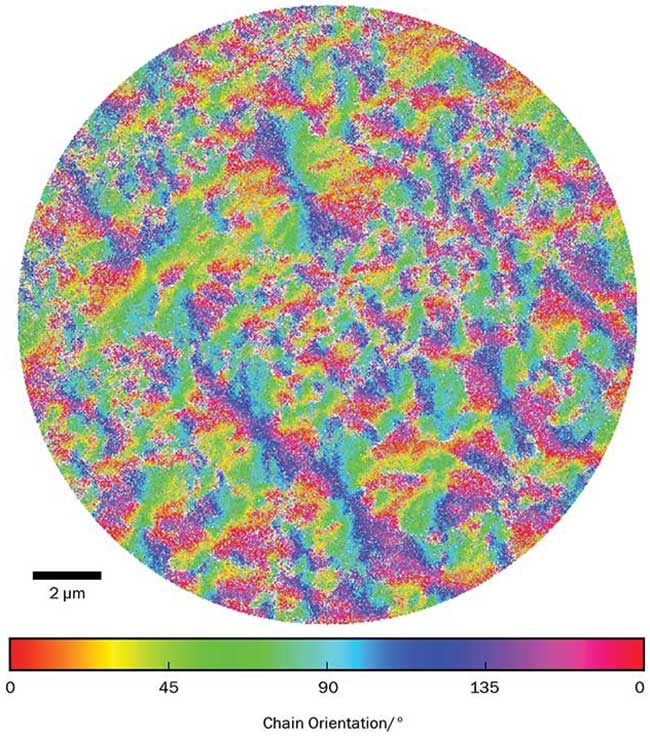
Figure 1. Two-photon photoemission electron microscopy (PEEM) can be used to map the orientation of crystalline grains in P3HT, as in this false-color image, and the degree of crystallinity (not shown here). Courtesy of A. Neff et al./Leibniz Institute of Surface Engineering, Leipzig.
Katrin Siefermann and colleagues at the Leibniz Institute of Surface Engineering in Leipzig, Germany, used photoemission electron microscopy (PEEM) to map film morphology based on absorption of two photons from a linearly polarized ultrafast laser1 (Figure 1). Here, the researchers used a one-box Ti:sapphire oscillator (Coherent Chameleon).
In associated studies, the researchers modified their technique in a pump-probe (time-resolved) configuration to provide critical measurement data on carrier dynamics at subpicosecond resolution and with a spatial resolution of about 20 µm. They used one of the new generation of sealed laser oscillators based on Yb-fiber (Coherent Fidelity 2). The 1070-nm output of this laser is frequency-doubled to 535 nm, and frequency tripled to 357 nm in a harmonic conversion module (Figure 2).
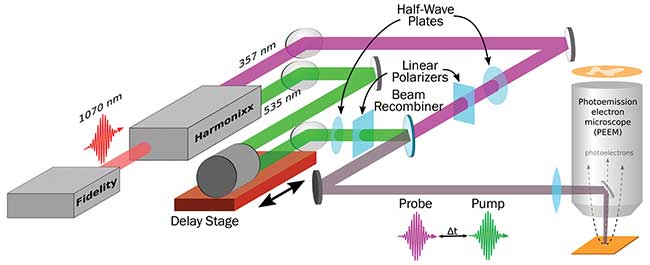
Figure 2. The pump-probe experimental approach used to measure the excited state relaxation dynamics at different locations across a thin film of P3HT spin, coated on a silicon/SiO2 substrate. The PEEM provides a quantitative spatial map of the photoelectrons. Courtesy of A. Neff et al./Leibniz Institute of Surface Engineering, Leipzig.
The two wavelengths are directed down separate paths toward the P3HT sample in the PEEM microscope. Each laser beam passes through a linear polarizer and half-wave plate to permit smooth adjustment of its polarization vector through 180º. The green (535-nm) beam also passes through a variable optical delay line, enabling computer control of the time delay between the two pulses.
The green pulse arrives at the P3HT sample first and creates free charge carriers in the form of electrons excited into the lowest unoccupied molecular orbital (LUMO). The UV pulse acts to further excite the sample, releasing a photoelectron that is detected in a PEEM microscope. By varying the time delay between the two pulses, the lifetime of the excited state can be measured in the form of a decay curve — PEEM intensity versus time (Figure 3).
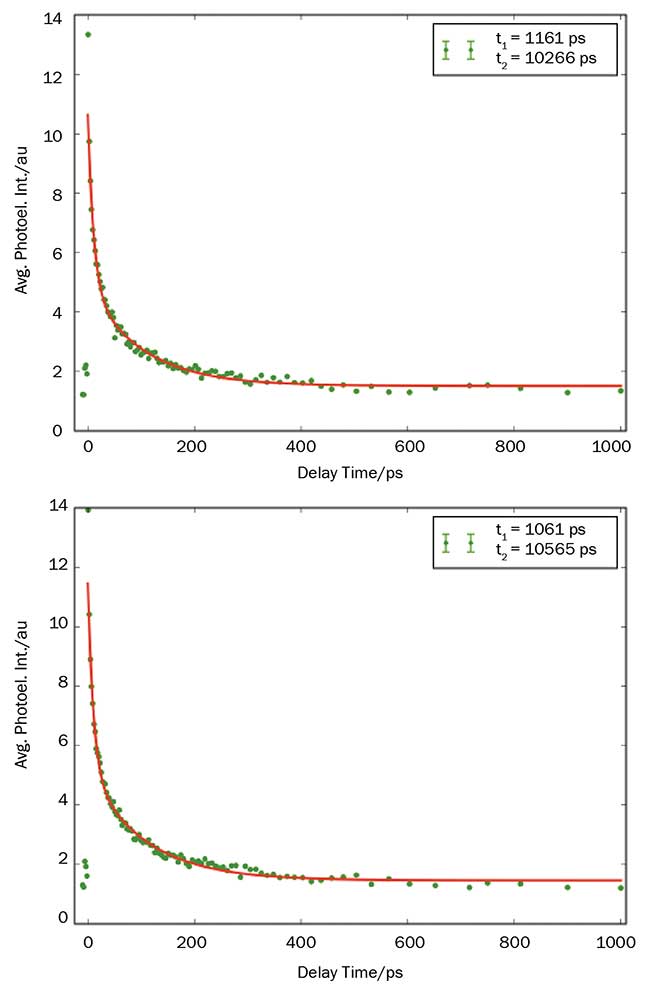
Figure 3. In time-resolved, two-photon PEEM, the decay curves of excited carriers in P3HT are virtually identical in these two plots. Each plot was recorded over a 6-hour period, with the two plots almost 20 hours apart. Courtesy of A. Neff et al./Leibniz Institute of Surface Engineering, Leipzig.
The low-signal (~1 electron or less) per laser pulse dictates the use of high (80 MHz) repetition rates to accumulate high signal-to-noise decay plots spanning 1 ns. Each experiment can take several hours. To rule out any artifacts and ensure that the ultrafast pulses have caused no sample damage, multiple experiments have been conducted on the same sample location over a 40-hour period. This type of study requires high output stability from the Yb-fiber laser, with beam pointing being a particularly critical laser parameter.
Chemists and photochemists are interested in finding efficient catalysts to enable artificial photosynthesis and other renewable fuel production methods. Specifically, they are seeking catalysts for carbon dioxide reduction reactions (CO2RR). Heterogeneous catalysts (e.g., surface-bound molecular catalysts) are considered promising candidates, but it is critical to understand if and how this surface binding modifies the catalytic action of the candidate molecule.
In this context, Wei Xiong and colleagues at the University of California San Diego have been using 2D spectroscopy (2D SFG, or sum-frequency generation) to study the binding geometry and dynamics of Re(diCN-bpy)(CO)3Cl (referred to hereafter as the catalyst) as a monolayer on a gold surface.
In conventional (linear) spectroscopy, the signal is measured as a function of the wavelength of light that is interacting with the sample. The signal can be absorption, fluorescence excitation, or Raman scattering.
Peaks correspond to quantum resonances in the sample and indicate unique structural information.
In 2D spectroscopy, a signal is generated as a function of two wavelengths and plotted against them.
The diagonal data in such a plot is simply the linear absorption spectrum. But all of the extra data from off-diagonal peaks and troughs, including their shape, intensity, and phase, provides information about coupling between the molecular resonances responsible for the spectral peaks.
The most common 2D spectroscopy is 2D IR, where the wide spectral bandwidth of two IR femtosecond pulses enables data to be recorded in the time domain. The data is then Fourier-transformed to generate frequency domain plots.
Studying monolayers of the catalysts on gold requires a spectroscopic technique that only produces resonant vibrational signals at the surface or phase interface. SFG spectroscopy, first demonstrated in 1987, is such a technique. Here, two intense laser beams (visible and IR) are focused on the interface. If the target is noncentrosymmetric, a weak visible wavelength beam at the sum of the two laser frequencies is generated.
When the IR laser wavelength is resonant with a vibration mode of the molecules at the interface, the probability of SFG increases by several orders of magnitude. Tuning the IR laser thus allows generation of a vibrational spectrum of surface-bound molecules only. While working in the research group of Martin Zanni of the University of Wisconsin-Madison, Xiong and colleagues2 showed that SFG could be combined into a 2D spectroscopy setup, and they published their first data in 2011.
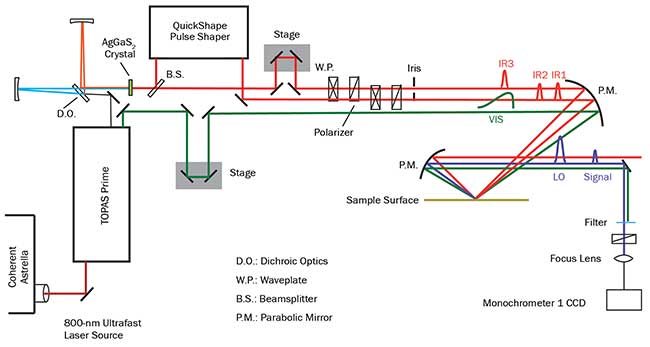
Figure 4. The Xiong group experimental setup is configured to support both 2D SFG (sum-frequency generation) and time-resolved 2D SFG. Courtesy of Wei Xiong/UC San Diego.
Xiong’s group has used 2D SFG to successfully interrogate catalyst on gold samples. Their setup (Figure 4) is based on a one-box Ti:sapphire ultrafast amplifier (Coherent Astrella) with a pulse energy of several millijoules. Because the signal is based on several nonlinear events and a thin sample layer, high pulse energy is critical. The 2D SFG data ultimately enabled the researchers to determine exactly how the catalyst was bonded to the surface (Figure 5).
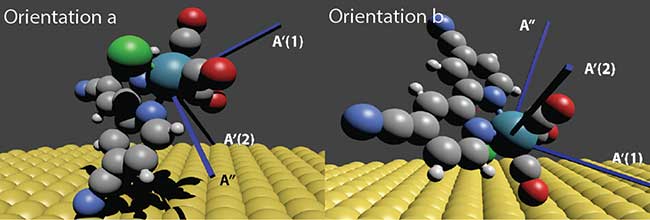
Figure 5. Orientations of the catalyst on a gold surface determined from comparing 2D SFG data and data from reflection-mode IR spectroscopy, simulated using density functional theory. Of two possible binding orientations, this showed that orientation “a” is preferred. The blue sticks represent the vibrational modes’ direction. Courtesy of Wei Xiong/UC San Diego.
They then extended the experiments into the time domain (i.e., 3D SFG) and determined how energy flow between two key vibrational modes is potentially affected by surface attachment. Laser amplifier stability was very important to this study.
“We sometimes have to average data for 48 hours, which puts extreme demands on laser stability,” Xiong said. “During this period, it is critical that the amplifier output be stable for beam pointing, beam quality, pulse energy, and so on. The hands-free stability of the amplifier means we can do these long data runs while remotely controlling the laser from an office near the laboratory.”
Imaging lymphatic vessels
No discussion of scientific lasers would be complete without at least one example of multiphoton microscopy, which represents the single biggest application type for ultrafast lasers. Although individual image sets may be acquired in minutes or even seconds, long-term laser reliability still can be critically important in these applications. For example, a team led by Friedemann Kiefer at the University of Münster is conducting time-sensitive experiments using valuable transgenic animals that require laser availability periods spanning weeks and even months.
“We are developing a detailed understanding of the growth of lymphatic vessels, which in turn has important implications for improved treatment of various medical conditions, including tumors, arteriosclerosis, and strokes,” Kiefer said. “We perform some of these studies using both live animals and in vitro organ and tissue samples from lab animals that have been humanely euthanized. The two-photon laser scanning microscope (2P-LSM) is our primary tool used to image these samples.”
Typical in vivo examples involve looking at vessels growing in a tumor via a skinfold chamber or looking at a stroke situation through a cranial window. The researchers examine different aspects of the vessel growth, including probing the role of various genes in controlling the functionality and development of the vessels. The team makes extensive use of genetically modified (transgenic) mice that express fluorescent proteins in a specific tissue or cell type, or over a particular time window. Moreover, they breed rare triple transgenics for some of these studies — the time and difficulty involved makes these extremely valuable lab specimens.
The experiments use one of the next-generation tunable one-box lasers based on Yb-fiber (Coherent Discovery).
“We need wide wavelength tunability to excite two or more fluorescent probes in the same experiment,” Kiefer said. “We also need high power at both of these near-infrared wavelengths in order to perform imaging as deep as 800 µm in the target tissue.”
In many of these experiments it is necessary to repeatedly image the same sample over a period up to several months (Figure 6).
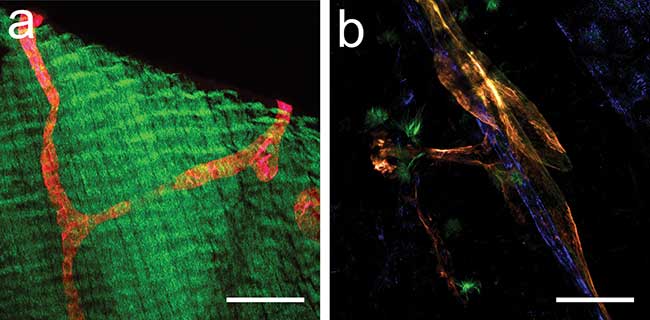
Figure 6. Two-photon laser scanning microscope (2P-LSM) images of a transgenic mouse expressing the tdTomato-protein under the control of a promoter that drives expression predominantly in lymphatic vessels. A lymphatic collector vessel (red) within the muscle of the diaphragm. Green fluorescence is generated by SHG of muscle fibers (a). Mesenterial lymph (orange) and blood (blue) vessels (b). Scale bar = 100 µm. Courtesy of Nils Kirschnik/EIMI Münster.
“Even in a small animal like a mouse, arteriosclerosis develops over weeks. And some tumors develop over an even longer time frame,” Kiefer said. “In a worst-case scenario, if we lose the ability to image in a certain time window in this period, then the entire experiment is lost.”
For this reason, he purchased a support program with a specific provision for remote service, with virtual service visits. If the laser ever has a problem, the group contacts Coherent, which then responds with a one-hour appointment time for the next day. The factory technician is given remote access via the internet and a local laptop link to the laser. When a minor performance issue has occurred, laser performance is restored to specification the next day, preventing loss in any experiment whatsoever, rather than waiting days for an in-person service call with potentially negative consequences.
Meet the authors
Darryl McCoy is director of product marketing at Coherent Inc., managing the ultrafast tunable and fiber laser products for nonlinear microscopy and instrumentation markets; email: [email protected].
Joseph Henrich is senior product line manager at Coherent Inc. He holds a Ph.D. in ultrafast studies from Ohio State University; email: [email protected].
References
1. A. Neff et al. (2017). Imaging nanoscale morphology of semiconducting polymer films with photoemission electron microscopy. Advanced Materials, Vol. 29, Issue 29, doi.org/10.1002/adma.201701012.
2. W. Xiong et al. (2011). Adding a dimension to the infrared spectra of interfaces using heterodyne detected 2D sum-frequency generation (HD 2D SFG) spectroscopy. Proc Natl Acad Sci USA, Vol. 108, Issue 52, pp. 20902-20907, doi.org/10.1073/pnas.1115055108.